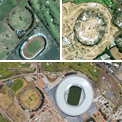Worldwide satellite coverage

No matter where the story is on the planet, Google Earth has satellite imagery for you to use. Over one quarter of the world’s land surface, covering over 60% of the world’s population, is in sub-meter high resolution — meaning each pixel represents an area smaller than one square meter, roughly enough detail to see a car windshield.
We frequently make updates our imagery database around the world, in an ongoing effort to accurately reflect the state of the world. And it’s all available to you, right now — just type any address in the bar at the top-left corner and you’ll fly there.
3D buildings: Use ours or make your own

Use the hundreds of thousands of 3D models available in Google Earth to give a highly realistic view of a city or a particular building. For a growing list of cities around the world, you’ll find photo-realistic models of all buildings in the downtown and surrounding neighborhoods. To make your shot match the hour, use the Time of Day feature — you can even animate the changing light.
If you need to show a building that hasn’t yet been modeled, it’s easy to model it yourself using Google SketchUp or Google Building Maker and place it directly in Google Earth.
Terrain: Mountains, valleys, and below the sea

In addition to buildings, Google Earth offers measurement-based terrain around the world. Show mountains, cliffs, valleys, and even trenches and continental shelves under the sea. For more dramatic presentation on-screen, you can exaggerate terrain by up to three times. Satellite imagery drapes precisely on top of the terrain, so when you can’t send a camera to take the shot, you can rely on Google Earth.
Most extensive map data

The road, landmark, and border data in Google Earth is the same as in Google Maps, which hundreds of millions of people around the world trust. In addition to full coverage in the countries where you’d expect it, we offer user-contributed map data from over 170 countries and territories through our Google Map Maker program. Often, our users have fully labeled roads, parks, and major buildings in countries where other digital maps show only a dot for a city. This extra detail, vetted by a moderation team, is invaluable when researching and creating maps to support news reports or features from far-flung parts of the world — and is instantly available when you turn on the Roads and Borders and Labels layers.
Historical imagery

Would you like to show how an old stadium was torn down and a new one put in its place? Then the Historical Imagery feature is for you. Google Earth offers imagery from the past several years worldwide. In the U.S. and select other locations, we have acquired older imagery, some going as far back as World War II, and many major cities offer a dozen or more views throughout time and during various seasons. Simply click the clock icon and scroll through time — the notches indicate every point in time for which we have a photo within the current view.
Thousands of layers

From real-time earthquake locations to undersea oil pipelines, airplane paths to demographic data, there are thousands of layers of geographic data available through the Google Earth ecosystem. Some are accessible through the layers on the left within the desktop version, while others can be found in the Google Earth Galleryor simply by adding the letters KML or KMZ to a web search to find files compatible with Google Earth. This sort of data can greatly enrich your news coverage, with a quick and compelling platform for visualizing geographic information.
Moon, Mars, and Sky

Should your news or feature story venture to the cosmos, Google Earth is here for you. Click on the planet icon to jump to the Moon, Mars, or the night sky. Moon and Mars offer the same sort of interactivity as Earth, and also features some rich on-the-surface content from Apollo missions and Mars rovers, respectively.
There’s a whole lot more you can do with Google Earth, and we invite you to learn more on our Help Center. The next step is to learn about the tools and techniques available for applying this powerful content to your broadcasting or publishing needs.


No comments:
Post a Comment